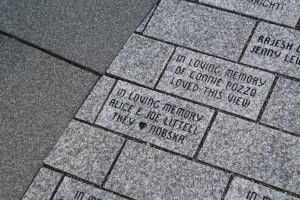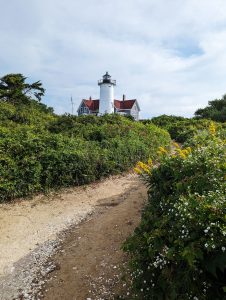Overlooking Vineyard sound, Nobska light sits high on a bluff beaming its light out over the water, helping to guide mariners through the Cape Cod passage. The exposed, windswept tower has stood sentinel since 1876. Alongside the tower sits a 2ó-story shingled building with all the appointments of home. It is the keeper’s house.

GILDA GEIST/ENTERPRISE
Memorial bricks like this one helped fund the restoration of the keeper’s house.
Lighthouses dotting the American coastline came with their attended keepers and assistant keeper. In the early days of the nation, in order to maintain quality year-round nighttime illumination, the lights needed constant attention. From trimming the wicks (a term for a lighthouse keeper would be wickies) to cleaning the lamps and windows to filling the oil, the lights required a sizable amount of attention in the pre-electrified world.
Depending on the size of the light, the keeper would have help from assistant keepers who shared in the duties under the head keeper’s direction, all with the purpose of keeping the light burning throughout the night and, when weather conditions warranted, the fog signal sounding. They were responsible for cleaning the glass that would be fouled by soot and clearing it of ice and snow— even in the dead of night. The allure of lighthouses sometimes obscures the fact that these stations hosted whole families who did what they could to make their outposts home.

GILDA GEIST/ENTERPRISE
Friends of Nobska Light vice president Patrick Burke inside the newly renovated keeper’s house.
The Cape Cod keepers’ houses were almost uniform in outward appearance; two-story, wood-shingled buildings built close to the light. Early photos show many of them painted white, and like much of mid-19th century Cape Cod, in a sea of meadow and grassland with few trees in sight. Today some of these houses are more obscured by trees whose growth is less checked by humans and sheep alike. A few lights still sit uncrowded by modern neighbors looking out over the water, such as Nobska light in Falmouth, Race Point light in Provincetown and Highland light in Truro. A precious few— Monomoy light and Tarpualin Cove light—stand utterly alone on windswept terrain that looks much like it did 150 years ago.
The lights themselves get a fair amount of attention. Most are still aids to navigation shining forth or bellowing out to mariners passing by. There is a certain romance and mystique about the shining sentinels that obscures the daily life of those who inhabited these structures. The pay for lighthouse keepers, never generous, was supplemented by some with fishing and other activities. Families kept gardens and livestock to bolster the supplies sent by the lighthouse service, and they lived off the sea. A photo from Monomoy light shows the keeper and his family in the midst of washing day, with clothes strung on a line like a ship turned out for a ceremony.

GENE M. MARCHAND/ENTERPRISE
A path winds its way to Nobska Light.
The life could be lonely and dull, punctuated by moments of terror and excitement. The daughter of the keeper of the Cuttyhunk lighthouse remembered helping her father tend to the light during the hurricane of 1944. A violent gust of wind blew the house’s chimney over and it came crashing through the roof and into her bedroom. Fortunately she was in the lighthouse at that time. During that same storm she witnessed the lights of the Vineyard Sound Lightship wink out; it sank with all hands.
At other posts children were separated from schools—though few lighthouses on the Cape were that far from civilization. The most remote, Monomoy, even had a village attached to it for a time—though by the 19th century this light stood alone among the sand dunes. Another island outpost also saw a shrinking village. Billingsgate Island in Cape Cod Bay hosted a fishing community along with its lighthouse through much of the 19 century. Around the time of the American Civil War the island began shrinking and the lighthouse toppled into the sea in 1915. Today Billingsgate is visible only at low tide.
A couple of lighthouses did not have a separate keeper’s dwelling and were instead self-contained. Known as stag stations, only men occupied them; they would have a rotating crew who would spend a few days on station and a few off. Bishop and Clerks, completed in 1858, stood outside Hyannis on the rocks of the same name. One harsh winter the sound froze over and the relief crew could not make it out. The food held out but the crew were on short-commons. Bishop and Clerks was demolished in 1952.
Cleveland ledge light in Buzzards Bay, now privately owned, is another such station that could be reached only by boat. Built in 1943 on a steel caisson at the mouth of the Cape Cod Canal, it had been manned by the US Coast Guard until 1989. A 4,800-gallon cistern held drinking and bathing water; all other supplies had to be brought in on a boat.
Lighthouses dot the Cape and still guide mariners. Their lights are still aids to navigation and their foghorns still hoot out their warnings. Some of the keepers’ homes have vanished; others have been repurposed. Nobksa light, whose keeper’s house is actually two houses connected, one for the keeper and one for the assistant keeper, was for years the Woods Hole Coast Guard base commander’s residence. Thanks to the dedication of local volunteers, it nowstands as a beautifully restored reminder of a lost profession and a way of life that seems so distant.

